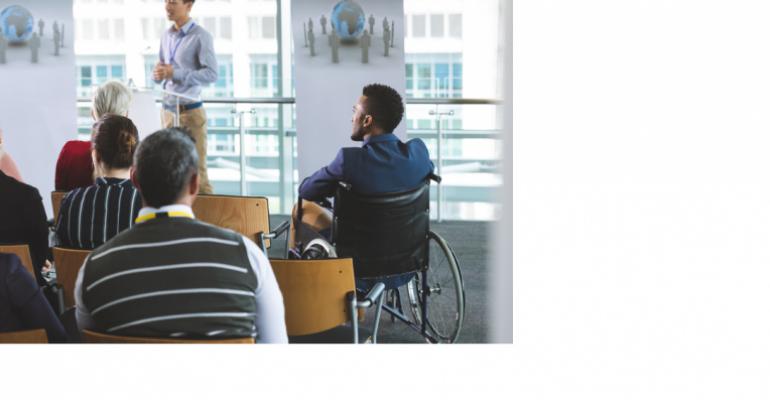“Patient centricity” is essential to future medical meetings—but while it’s a trend on the upswing, there are barriers to success that must be overcome, says a recently released whitepaper from BCD Meetings and Events.
The report, “Patients in Meetings: How Patient Involvement Has Evolved and What to Expect in the Next Decade,” also details the benefits of having patients take part in HCP events, including those organized by biotech, med-device, and pharma firms that traditionally are less likely to include patients. And the good news is that “patient participation is increasing and can be observed at touchpoints ranging from non-clinical trials to medical congresses to patient-ambassador programs.” While not all meetings are appropriate for patients, the paper says, meeting hosts “often view patients’ presence at meetings as a significant value-add.”
That perspective is gaining traction across the corporate-event sector. For example, Eyeforpharma, which was to be held April 15-16 in Philadelphia but is now postponed, had dedicated time in its itinerary for executives from several hundred life-sciences firms to discuss advocacy strategies for driving the next generation of patient-centric platforms, including in-person and virtual meetings.
Naturally, patients and their families are supportive of the idea that they can play a beneficial role at medical meetings. The report found that “many patients want to be involved in the medical advancements of the disease state that they or a loved one are afflicted with; some are desperate to learn about cutting-edge research being carried out; and others have valuable experience and ideas to contribute.”
Nonetheless, “I find myself asking why it isn’t easier for us to engage and involve the exact population, patients and patients’ families, that we are all aiming to help and support,” Melissa Nahama, senior director for BCD’s Life Sciences Center of Excellence, told MeetingsNet. “We are living in an increasingly technological and global healthcare environment that provides us with immense opportunity and options that certainly have enhanced and improved our ability to connect, and in many ways have accelerated our ability to deliver results and solutions. That said, when it comes to patient involvement and participation in reaching these important life-science meetings audiences, we haven’t really been able to make this an easier and more common occurrence.”
Roadblocks to Patient Participation
It’s not a revelation that life-sciences companies have significant legal, regulatory, and other reasons for moving gradually and warily towards increasing the role of patients at their HCP events. First, the report states that “compliance issues act as a barrier for patient inclusion. Some believe there should be more guidance from regulatory agencies” to facilitate patient participation, “while others think there is already too much regulation” hampering their patient-inclusion possibilities. A legal complication might arise from patients who mention adverse effects or off-label uses of products during a meeting, or who become privy to collaborative efforts in drug development, scientific research, or clinical research. For the latter reason, “executives might feel nervous about or are simply unaccustomed to having patients present for those deliberations.”
 Other challenges include the traditionally hierarchical nature of the medical field, where “some practitioners might object [to patient participation] because they fear the ‘scientific core’ of meetings might diluted if the public becomes involved.”
Other challenges include the traditionally hierarchical nature of the medical field, where “some practitioners might object [to patient participation] because they fear the ‘scientific core’ of meetings might diluted if the public becomes involved.”
Yet another reason that might hold back patient participation is one that event planners understand well: “They must often contend with organizing complex logistics for patients and cover financial items such as registration, travel costs, accommodations, food costs, and the appointment of mentors to guide patients and their families during the conference” for their event performance as well as for their safety and comfort.
Videoconferencing technology can eliminate both the proprietary-information issue and the patient-accommodation issue, but does not offer meeting attendees full access to patients that can bring the deepest perspective.
Benefits to Patient Participation
Traditional patient-ambassador programs, where participants are trained and vetted by a life-sciences company before they interact with event attendees, have proven to increase patient satisfaction measures, reduce complaints, and improve safety metrics. However, there are other ways to use patients at either association or corporate events to give HCPs a more holistic understanding of the patient experience, including the psychological aspect.
Among the 337 meeting-budget owners who were surveyed for BCD’s white paper, some gave specific reasons why patient involvement in the form of presenters, panel participants, or simply attendees helps both HCPs and employees of a company hosting an event. “We can more deeply and fully understand what it is like to live with a condition, the challenges they face, and where the unmet needs lie,“ said one respondent. “It provides a real-life perspective of what it is like to suffer from a particular condition, and reminds our trainees of why we do what we do,” said another.
To make this happen, “meeting and event managers need to have a seat at the table early on,” says BCD’s Nahama. “Having a clear understanding of goals and objectives for a meeting and the ability to have dialogue with meeting stakeholders as concepts and ideas are being discussed builds trust and confidence that, as they work in this unique space, they feel they are not simply providing logistics fulfillment but also delivering value that will impact lives.”
As for BCD’s role in this effort, “certainly we need to consider the regulatory environment that governs how pharma, biotech, and med-device organizations operate,” Nahama says. “Compliance, privacy, safety and security, logistics–it all matters and needs to be considered for all attendees. The patient-attendee may have some additional things to consider but given the unique voice and first-hand experiential testimony they alone can offer, the value they bring will very often outweigh the additional budget and planning required to ensure their safety and comfort.”
To read the full white paper, which includes all survey results plus brief case studies, click here.





